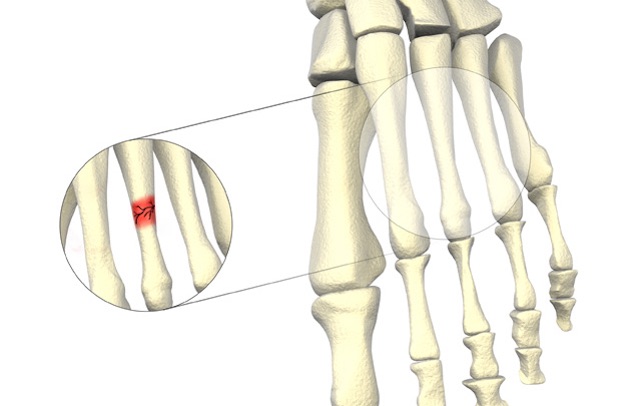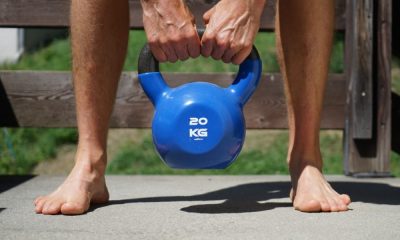
As a runner it can be distressing when diagnosed with a stress fracture, frightening images of plaster casts and crutches, along with the inevitable question of whether it is the end of running, all run through your mind.
A stress fracture is a classic overuse running injury and can be very common amongst long-distance runners. It first begins with a micro-fracture developing when the loads and stresses placed on the bone exceed its ability to manage with the strain, remodel and heal.
The accumulation of this microtrauma from a repetitive activity such as running results in fatigue failure in the bone. Under normal circumstances, the body and can cope with this with appropriate rest and training, but if the microtrauma continues excessively then this can lead to a stress fracture developing.
What causes a stress fracture?
Just as with any other injury it is helpful to both runner and the treating clinician to understand the possible factors that may have contributed to the development of the fracture. Excessive mileage, a sudden increase in training and not enough rest are factors that can contribute to a lower limb fracture.
It is also worth looking at the surfaces the runner has been training on, the condition of running shoes or new shoes, and whether the runner has been using equipment inappropriately, such as a weighted vest.
Nutrition and diet can also be contributors to a stress fracture first developing. Particularly with female runners, poor nutrition and irregular menstruation can increase the risk of a stress fracture. And then there are other risk factors that are more intrinsic such as muscle weakness, biomechanical issues and pre-existing medical conditions.
For more on nutrition and stress fractures read ‘7 Nutrients & Foods That Help Prevent Stress Fractures‘.
Signs you may have a stress fracture in the lower limb
The main symptom of a stress fracture is pain which usually develops gradually, and the pain is further aggravated by exercise. Occasionally the pain can occur while walking or with rest and can become an issue at night. There will be tenderness on the site of the fracture e.g. if the stress fracture is in the shin bone (tibia) then the shin will be tender.
Most common stress fractures in runners
The shin bone (tibia) is the most common site of stress fracture for endurance runners followed by the metatarsal bones of the foot.

Stress fractures of the navicular bone of the foot tend to occur more often in sprinters, middle distance athletes and jumpers.
Stress fractures of the neck of the femur (hip) and the pelvis are less common but do occur in endurance runners.
What to do?
If a stress fracture is suspected then the first thing to do is to get help. Other overuse injuries need to be ruled out first and it may be that a stress fracture hasn’t yet developed but the warning signs are there. Your GP or sports doctor may also decide to investigate further with an X-Ray, MRI or ultrasound scan to confirm the diagnosis.
How is a stress fracture treated?
The main management for any stress fracture initially is rest. This will mean rest from the activity that aggravates the pain, usually weight bearing, so possibly no running for a while.
The imposed rest period will vary depending on the site of the fracture and its severity. In some cases, an air cast splint (a great big boot) can be used if the fracture is in the lower part of the leg to enable some weight bearing while the pain settles.
Depending on the site of the fracture through the treatment may be slightly different and may require longer periods of rest and in some cases further investigations to establish a cause.
As pain reduces and the tenderness at the fracture site settles, you can begin activity again under the guidance of your clinician. For runners, cross training such as aqua jogging will enable you to keep your fitness levels up until weight bearing activities are permitted.
Strength work may also be advised if weak supporting muscles were found as a possible contributing factors. As a physiotherapist, I have had success with walk/run programmes while rehabilitating runners with stress fractures. It allows gradual loading of the fracture site without overloading the area and causing a relapse in pain.
Preventative measures
It may sound simple, but the best thing you can do is try and avoid a stress fracture occurring in the first place. Training smart, and avoiding overtraining, excessive mileage and progressing too quickly in new activities or sessions are all ways to help prevent the overload of tissue such as bone.
Revisit your diet to ensure you are eating the required nutrients for bone health especially if we are running high weekly mileage. If you are unsure, it might be helpful to get professional advice from a qualified dietician with experience in sport. Female runners who are prone to missed periods need to seek advice from their GP as nutrition; the menstrual cycle and bone health are interlinked.
Also, make sure you have adequate recovery time for the body to have adequate time to repair in between hard sessions.
It is important to note though that a stress fracture doesn’t mean your running is over, and with the right treatment, advice and considerations of the factors that may have caused the injury in the first place, runners can get back out there after a stress fracture, pain-free.
About the Author
Kathleen Walker is a physiotherapist, runner and owner of Fast Track Physio. A lover of track, road and cross country, Walker has over ten years experience in treating all levels of runners, from beginners to elite.



















